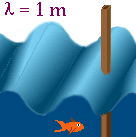How Do We Detect What is Happening? Wavelength and Resolution Explained
 Things with long wavelengths are analogous to the basketball in the cave
story because neither can provide too much detail about what they hit.
Things with short wavelengths are like the marbles in that
they can provide you with fairly
detailed information about what they hit.
The shorter the probe's wavelength is,
the more information you can get about the target.
Things with long wavelengths are analogous to the basketball in the cave
story because neither can provide too much detail about what they hit.
Things with short wavelengths are like the marbles in that
they can provide you with fairly
detailed information about what they hit.
The shorter the probe's wavelength is,
the more information you can get about the target.
 A good example of the wavelength
vs. resolution issue is a swimming pool. If you have a swimming pool
with waves which are 1 meter apart (a 1 meter wavelength) and push a stick
into the water, the pool's waves
just pass around the stick because the
1 meter wavelength means that the
pool's waves won't be affected by such a tiny target.
A good example of the wavelength
vs. resolution issue is a swimming pool. If you have a swimming pool
with waves which are 1 meter apart (a 1 meter wavelength) and push a stick
into the water, the pool's waves
just pass around the stick because the
1 meter wavelength means that the
pool's waves won't be affected by such a tiny target.
All particles have wave properties.
So, when using a particle as a probe,
we need to use particles with short wavelengths to get detailed information
about small things. As a rough rule of thumb, a
particle can only probe down to distances
equal to the particle's wavelength.
To probe down to smaller scales, the
probe's wavelength has to be made smaller.
This is all a very hand-wavy explanation of a very
difficult concept.
To explain it completely would involve
more math than we have space to get into.
|



